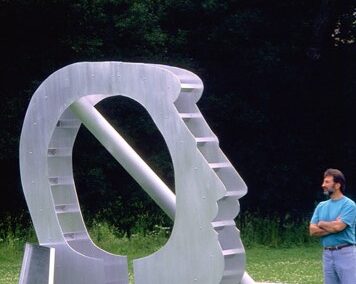Our latest Artist You Need To Know is someone whose works straddle abstraction and symbolism, and are often monumental sculptures that explore process while almost overpowering the viewer with their sheer size, texture and often vibrant colours.
Patrick Thibert was born in Windsor, Ontario, in 1943. He studied chemical technology at the Western Institute of Technology, Windsor, 1961 – 65, but then moved forward to study fine art at the University of Windsor, obtaining a BFA there in 1972, then an MFA from the Florida State University (at Tallahassee), in 1974.
-

Journey No.1, 2017
-

Journey No.7, 2017
-

Journey No.3, 2017
-

Nazca No.2, 2019
-

Journey No. 20 - 2, 2020
-

Fusion No. 3, 2020
He has worked mainly three dimensionally over the arc of his career. His work has moved from being primarily abstract through the 1970s and into the early 1980s to then engaging with and exploring narrative, symbols and metaphors for several ensuing decades. Many of these sculptures have dealt with aspects of his life as a springboard to developing new ways at presenting his sculptural ideas (such as in The Portrait of the Artist series, The Mind of the Viewer series, the Billie series and culminating in the Icarus series). In 2011, Thibert began to re examine abstraction and his relationship with it. His sculptures have continually made use of and have combined a variety of processes and materials to develop his work.
In an interview in 2018, Thibert offered the following: ‘I have always been open to where I might be going next. It really has to be a natural process for me.’
Over the past half century, he has given lectures about his work in a variety of public venues across Canada and the United States. (from his site) His work has also been exhibited through the Olga Korper Gallery, Paul Kuhn Gallery and the Thielsen Gallery.
-

Portrait of the Artist: Homage to Cezanne, Series VIII, No. 2 (study), 1992 - 1993
-

Cantoria of Anger No. 1, 1997
-

Measured Anger, 1997
-

Portrait of the Artist: 1, 2, 3, Series I, No 1, 1992
-

Portrait of the Artist: 1, 2, 3, Series II, No. 1, 1992
-

Portrait of the Artist, 1993
Thibert’s own site is extensive: you’ll not only find images of his work going back to the 1970s, but concise and informative commentary from the artist about the ideas at play in his work. We encourage you to visit, as many of the works we’ve shared here have further documentation there that truly captures the physicality of his art, and gives a fine sense of the materials that so often inform his practice.














